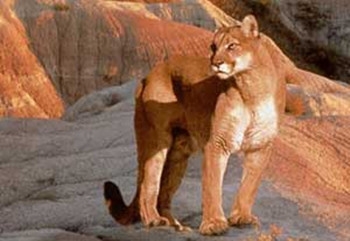
These holes are the unmistakable hallmark of a violent death. Their shape suggest they were made by the teeth of a big cat, but which one? Today there’s only one large cat in the region, the Florida panther. Though similar to the cougar at the western states, it's now much rarer. But it was around during the ice age, so could it have killed the glyptodont?
這些裂孔無疑出自一位猛烈的“死亡收割者”。從形狀上看,他們出自一種大型貓科動物的牙齒,但是是哪一種呢?今天,在這片區(qū)域只存活著一種大型貓科動物——佛羅里達(dá)豹。盡管和西部各州的美洲獅有很多相似之處,但是他們卻更為稀少。然而換作是在冰河時代,他們能殺死雕齒獸嗎?
Although it could easily manage a deer, the Florida panther was probably too small to tackle such a giant. But it wasn't the only big cat around 13,000 years ago. There was also the mighty American lion, powerful enough to kill a glyptodont.
盡管能夠輕易獵殺一只鹿,但是佛羅里達(dá)豹的體型卻沒有大到能夠?qū)Ω度绱艘粋€大型動物。但是在13000年以前,大型貓科動物的種類更多。例如大美洲獅,他們十分強大,殺死一只雕齒獸綽綽有余。
The scimitar-toothed cat, known to attack young mammonths, was also big and strong enough. And then there was the most infamous cat of all, the sabertooth. Like the scimitar, it saved its awesome fangs for slashing soft flesh. It would have been unlikely to risk breaking them on bony armor. But the warm climate of ice age Florida made it a sanctuary for another killer cat. Still South America's top predator, the jaguar is capable of taking prey much larger than itself. Weight for weight, it's probably the most powerful cat alive today.
這種牙齒呈月牙狀的貓科動物經(jīng)常捕殺年幼的猛犸象,他們體型巨大且十分強壯。而另一個例子就是鮮為人知的劍齒虎。和大美洲獅的月牙狀牙齒一樣,他們也有著長長的牙齒,并用此來撕扯柔軟的肉。但要是用他們在撕咬骨盔也并不可行。然而溫暖的氣候使冰河時代的佛羅里達(dá)成為了另一種貓科“殺手”的避難所,這種貓科動物同樣是南美州的頂層捕獵者——美洲虎,它們能夠獵殺比自身體型大得多的動物。同樣,它們也可能是當(dāng)今存活的最為強大的貓科動物。
英文文本來自普特英語,譯文屬可可原創(chuàng),僅供學(xué)習(xí)交流使用,未經(jīng)許可不得轉(zhuǎn)載.











